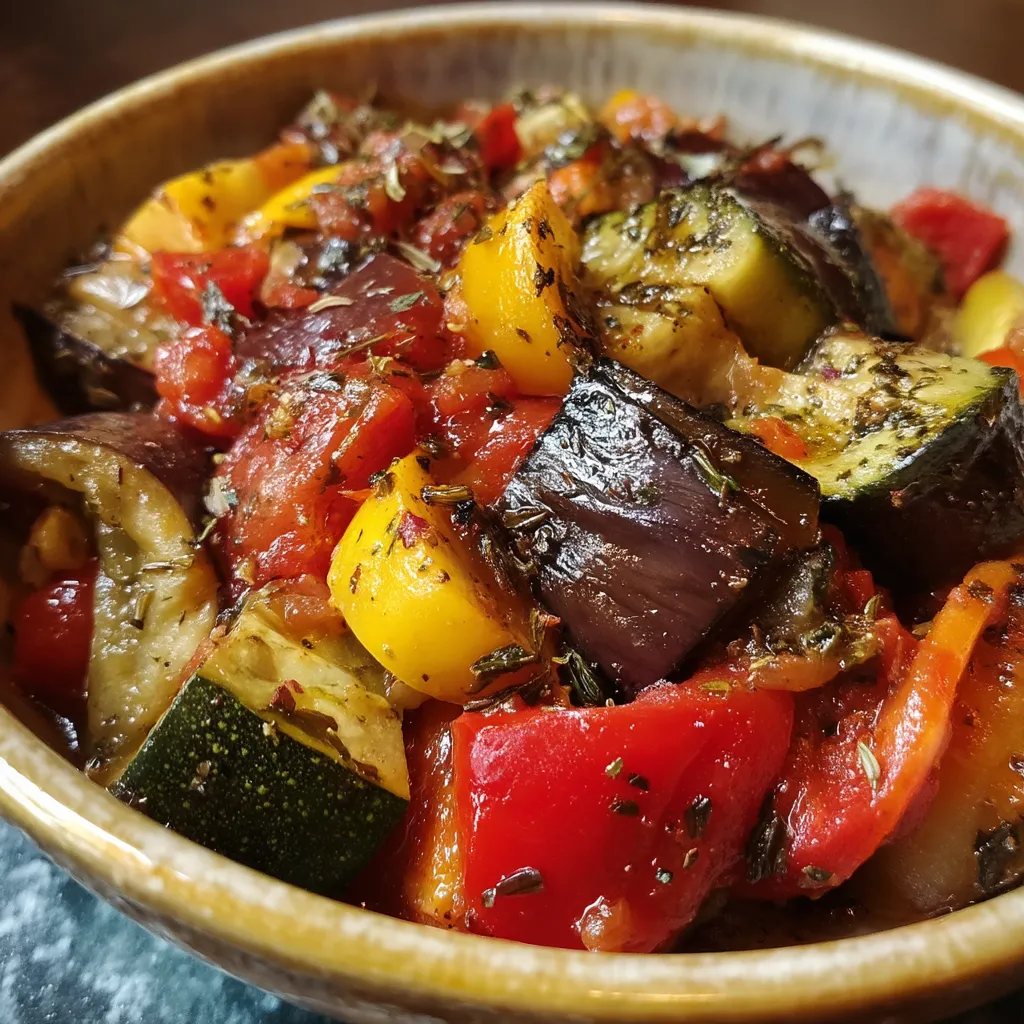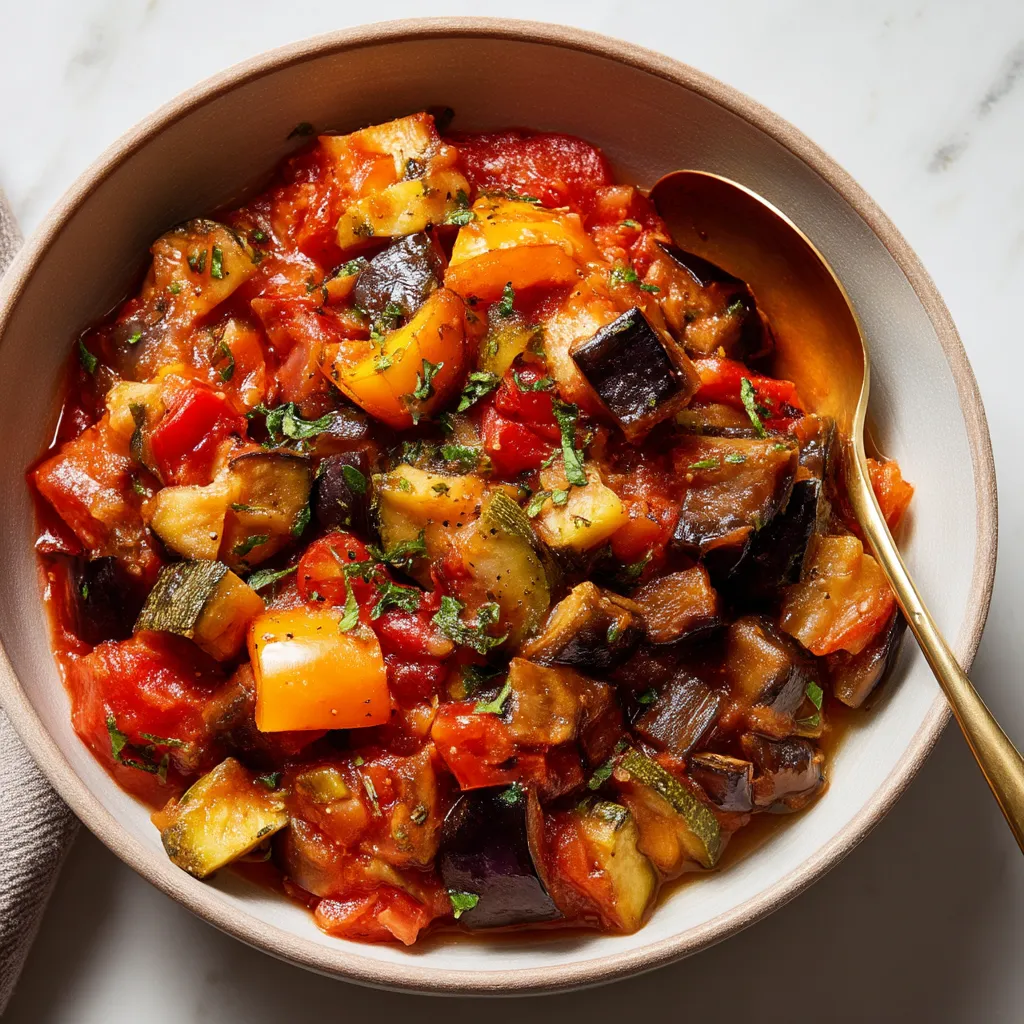 Save It
Save It This rustic Provençal ratatouille transforms humble vegetables into something truly magical, capturing the essence of southern French countryside cooking in every bite. The gentle simmering in olive oil and herbs creates a dish where each vegetable maintains its integrity while melding into a harmonious whole.
I first made this ratatouille after returning from a trip to Nice, desperate to recreate the flavors I experienced in that small family restaurant overlooking the Mediterranean. Now it has become my signature dish whenever I host summer dinner parties on the patio.
Ingredients
- Extra virgin olive oil: Offers a fruity foundation crucial for authentic Provençal flavor
- Eggplant: Absorbs other flavors beautifully when properly browned first
- Zucchini and yellow squash: Provide a tender sweetness when cooked just right
- Bell peppers: Add vibrant color and subtle sweetness; choose firm ones with glossy skin
- Fresh tomatoes: Create the silky base; look for ripe but firm varieties in summer
- Herbes de Provence: The signature seasoning blend that defines this dish
- Fresh basil: Added at the end brings bright aromatic notes that elevate everything
Step-by-Step Instructions
- Prepare Vegetables:
- Dice all vegetables with care to ensure even cooking. The traditional Provençal method calls for larger chunks rather than tiny pieces, allowing each vegetable to maintain its distinct character while still melding with the others. Aim for pieces about three quarters of an inch.
- Cook Eggplant First:
- This critical first step prevents the eggplant from becoming soggy. Eggplant requires its own cooking phase in plenty of olive oil until it develops a light golden exterior. This creates texture and prevents the eggplant from disappearing into the final dish.
- Layer The Flavors:
- Cook each vegetable group separately before combining. This technique allows you to control the doneness of each component perfectly. The onions and peppers need that slight caramelization, while the garlic requires just enough heat to become fragrant without burning.
- Create The Base:
- The tomato mixture forms the soul of ratatouille. Allow it to simmer briefly before adding back the other vegetables. This concentrates flavors and begins developing that signature sauce that will bind everything together.
- Gentle Final Simmer:
- The magic happens during this phase. A low, slow simmer allows all the vegetables to become tender while releasing their flavors into the olive oil base. Resist the urge to stir too frequently about every 5 to 7 minutes is perfect.
- Rest Before Serving:
- Let your ratatouille stand for at least 15 minutes before serving. This resting period allows the flavors to settle and meld further. The difference between serving immediately and after a brief rest is remarkable.
 Save It
Save It My grandmother from Marseille taught me to salt the eggplant lightly before cooking to draw out any potential bitterness. Though modern eggplants rarely have this problem, I still follow her ritual as a connection to those summer afternoons we spent cooking together in her tiny kitchen overlooking the port.
Temperature Matters
The secret to perfect ratatouille lies in temperature control. Medium heat works for the initial sautéing of each vegetable, but the final simmer must be gentle. Too high a temperature will cause the vegetables to break down completely, creating a mushy texture rather than the distinct pieces suspended in a flavorful sauce that defines a proper ratatouille.
Seasonal Adaptations
While summer offers the ideal vegetables for traditional ratatouille, you can adapt this recipe year round. In winter, substitute canned tomatoes for fresh and consider adding root vegetables like turnips or parsnips for a heartier version. The cooking method remains the same, though winter vegetables may require slightly longer cooking times to reach the perfect tenderness.
 Save It
Save It Serving Traditions
In Provence, ratatouille is rarely served piping hot. Instead, it's typically enjoyed at room temperature or just slightly warm, allowing the full spectrum of flavors to be appreciated. Traditionally, it's accompanied by crusty bread for soaking up the flavorful juices. For a complete meal, serve alongside grilled fish, roasted chicken, or atop creamy polenta for a more substantial offering.
Storage Solutions
Ratatouille actually improves with time as the flavors continue to develop. Store in an airtight container in the refrigerator for up to 5 days. To freeze, cool completely then portion into freezer safe containers. It will maintain quality for up to 3 months frozen. Thaw overnight in the refrigerator and gently reheat on the stovetop with a splash of water if needed.
Common Questions About Recipes
- → What's the difference between ratatouille and confit byaldi?
Traditional ratatouille is a rustic stew where vegetables are typically sautéed separately then simmered together. Confit byaldi is a refined variation where vegetables are thinly sliced and arranged in an elegant pattern over a tomato base, then baked in the oven. The cooking method creates different textures and presentations while using essentially the same ingredients.
- → Can I make ratatouille ahead of time?
Absolutely! Ratatouille actually improves in flavor when made a day ahead as it allows the flavors to fully develop and meld together. Simply refrigerate in an airtight container after cooling and gently reheat when ready to serve, or enjoy at room temperature.
- → What are herbes de Provence?
Herbes de Provence is a traditional French herb blend typically containing savory, marjoram, rosemary, thyme, and oregano. Some variations may include lavender, fennel seeds, or bay leaf. If you don't have the blend on hand, you can substitute with a mixture of these herbs, particularly thyme and rosemary.
- → Is it necessary to sauté each vegetable separately?
While not absolutely necessary, sautéing vegetables separately helps each maintain its distinct texture and prevents them from becoming mushy. Eggplant especially benefits from cooking separately as it absorbs oil differently than other vegetables. This method creates a more texturally interesting and visually appealing final dish.
- → How can I serve ratatouille?
Ratatouille is incredibly versatile. Serve it as a main dish with crusty bread, as a side to roasted meats, or as a topping for polenta, pasta, rice, or couscous. It's delicious warm, at room temperature, or even cold, making it perfect for meal prep and picnics. You can also use it as a filling for omelets or as a topping for bruschetta.
- → Can I freeze ratatouille?
Yes, ratatouille freezes well. Allow it to cool completely, then transfer to freezer-safe containers, leaving some headspace for expansion. It can be frozen for up to 3 months. Thaw overnight in the refrigerator and gently reheat on the stovetop, adding a splash of water or olive oil if needed to refresh the consistency.